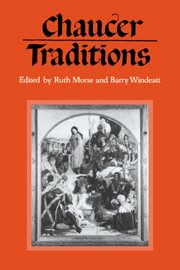Book contents
- Frontmatter
- Contents
- List of contributors
- Preface
- Note on the text
- 1 Chaucer traditions
- 2 Gower–Chaucer's heir?
- 3 Chaucer and Lydgate
- 4 Hoccleve and Chaucer
- 5 Chaucer and fifteenth-century romance: Partonope of Blois
- 6 Some Chaucerian themes in Scottish writers
- 7 The planetary gods in Chaucer and Henryson
- 8 Gavin Douglas: ‘Off Eloquence the flowand balmy strand’
- 9 Skelton's Garlande of Laurell and the Chaucerian tradition
- 10 Chaucerian metre and early Tudor songs
- 11 Aspects of the Chaucerian apocrypha: animadversions on William Thynne's edition of the Plowman's Tale
- 12 The shape-shiftings of the Wife of Bath, 1395–1670
- 13 The genius to improve an invention: transformations of the Knight's Tale
- 14 From the Clerk's Tale to The Winter's Tale
- 15 The Virtuoso's Troilus
- 16 Rewriting romance: Chaucer's and Dryden's Wife of Bath's Tale
- 17 Chaucer's religion and the Chaucer religion
- 18 A list of the published writings of Derek Brewer
- Index
12 - The shape-shiftings of the Wife of Bath, 1395–1670
Published online by Cambridge University Press: 23 September 2009
- Frontmatter
- Contents
- List of contributors
- Preface
- Note on the text
- 1 Chaucer traditions
- 2 Gower–Chaucer's heir?
- 3 Chaucer and Lydgate
- 4 Hoccleve and Chaucer
- 5 Chaucer and fifteenth-century romance: Partonope of Blois
- 6 Some Chaucerian themes in Scottish writers
- 7 The planetary gods in Chaucer and Henryson
- 8 Gavin Douglas: ‘Off Eloquence the flowand balmy strand’
- 9 Skelton's Garlande of Laurell and the Chaucerian tradition
- 10 Chaucerian metre and early Tudor songs
- 11 Aspects of the Chaucerian apocrypha: animadversions on William Thynne's edition of the Plowman's Tale
- 12 The shape-shiftings of the Wife of Bath, 1395–1670
- 13 The genius to improve an invention: transformations of the Knight's Tale
- 14 From the Clerk's Tale to The Winter's Tale
- 15 The Virtuoso's Troilus
- 16 Rewriting romance: Chaucer's and Dryden's Wife of Bath's Tale
- 17 Chaucer's religion and the Chaucer religion
- 18 A list of the published writings of Derek Brewer
- Index
Summary
The multitude of readers who have been captivated, since Chaucer's own time, by the Wife of Bath, is matched by the multitude of different interpretations of her. She is shrew, virago, femme fatale; she is the voice of feminism, or the projection of centuries of male misogynist fantasy. She represents Eve, or all of mankind that refuses to be born again in the Redemption; she stands for joy and vitality against a life-denying and cheerless orthodoxy. Her character is a mirror of Chaucer's own, a patchwork pastiche of other people's writings, open to deep Freudian psychoanalysis, or the greatest creation before Falstaff. She is the antifeminists' nightmare come true, whom no man within the fiction of the Tales can resist when once she has marked him down.
There is some evidence for all of these contradictory readings in the text, and Chaucer adds yet more through the way he tells the Wife's Prologue and Tale. The one thing that everyone who has ever heard of the Canterbury Tales knows about it, that the Wife demands female sovereignty in marriage, is itself put into doubt by the end of both her Prologue and her Tale. The vicissitudes of her relationship with her fifth husband, the clerk Jankin, end not with their fight but with their reconciliation:
I was to hym as kynde
As any wyf from Danemark unto Ynde,
And also trewe, and so was he to me.
(in, 823–5)- Type
- Chapter
- Information
- Chaucer TraditionsStudies in Honour of Derek Brewer, pp. 168 - 184Publisher: Cambridge University PressPrint publication year: 1990
- 21
- Cited by



